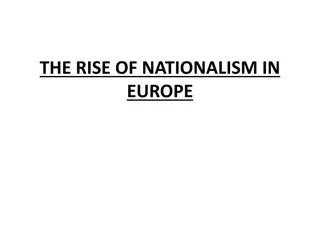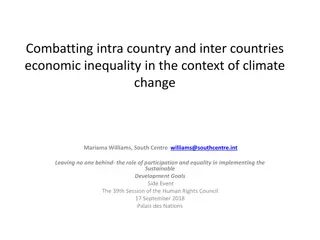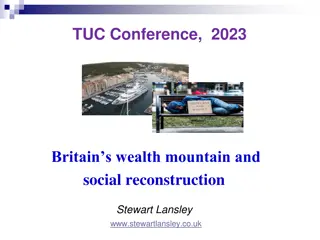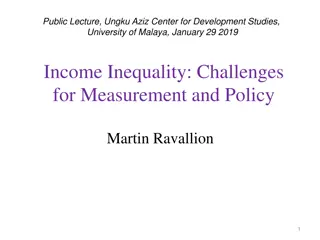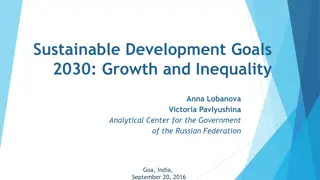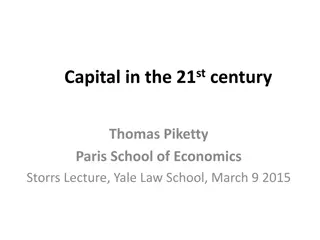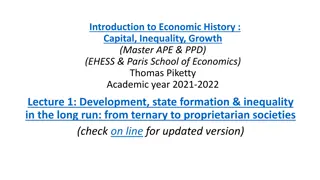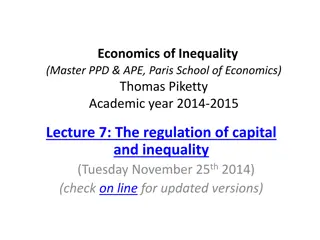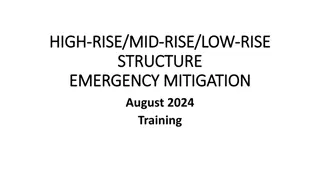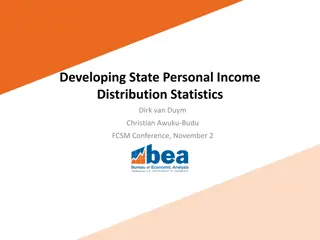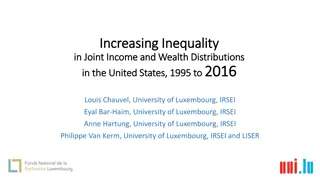Rise of Inequality in UK and Western Europe
This discusses the correlation between debt, real estate, and inequality in the UK and Western Europe since 1970. It highlights the impact of housing wealth, credit dynamics, and economic policies on social and political structures.
Uploaded on Mar 08, 2025 | 0 Views
Download Presentation

Please find below an Image/Link to download the presentation.
The content on the website is provided AS IS for your information and personal use only. It may not be sold, licensed, or shared on other websites without obtaining consent from the author.If you encounter any issues during the download, it is possible that the publisher has removed the file from their server.
You are allowed to download the files provided on this website for personal or commercial use, subject to the condition that they are used lawfully. All files are the property of their respective owners.
The content on the website is provided AS IS for your information and personal use only. It may not be sold, licensed, or shared on other websites without obtaining consent from the author.
E N D
Presentation Transcript
Debt, Real Estate, and the Rise of Inequality in the UK and Western Europe from 1970 Avner Offer University of Oxford GLOBAL DEBT DYNAMICS INITIATIVE University of Sussex, 26 May 2016
Piketty model of inequality: r>g Piketty wrong 70 percent of the time Alvarez et al. 2013 If not for last forty years, he would be wrong all the time What happened in last forty years?
Two Stories: Money and Housing (1) THE MONEY STORY Up to 1970s, credit repression. Fixed exchange rates: Bretton Woods, Gold Standard 1970s: floating exchange rates. Justified by faith in markets. Credit de-regulated. Where does money come from? Not from depositors. Originated by commercial banks. Does not require intermediation or prior deposits. Endogenous money theory. Evidence: Bank balance sheets (assets, loans) grow tenfold as percentage of GDP. In UK, from 0.5 of GDP to five times GDP. No other plausible source of liquidity for such an increase in deposits. Banks create money by lending it.
(2) THE HOUSING STORY But money not easy to lend. De-industrialisation: shortage of productive investments. International trade imbalances add pressure to lend. Housing - ideal asset: built-in collateral. Demand insatiable: rises with income. Subsistence and status good. Largest consumer expenditure. House prices driven by credit. Credit used for price-bidding competition. Competition cannot be avoided. Pays off. Wealth grows faster than debt. Also of paid-off housing. Housing windfall economy. Everyone seems to benefit. Two-thirds of population. Social and political support from wealthy. Tax relief: Imputed rental not taxed, mortgage interest deductions, no capital gains tax, regressive local taxation, low/no inheritance tax. Releases income for more borrowing and higher house prices. WINDFALL NEEDS CREDIT TO CONTINUE.
Household debt rises much faster than income Isaksen et al., 2011
Housing wealth grows faster than debt Isaksen et al., 2011 Top category is balancing item, not truly household wealth
Loose credit drives inequality and instability Debt service takes rising share of labour income. Falling labour share of GDP. Young and low-earners unable to buy. Housing shortage and inequality. Housing/social crisis. Lost generation of renters. Intermediaries (FIRE) take a big cut. Sector 14-35% of GDP in UK. Debt service withdrawn from consumption of goods and services Transfers from spenders to hoarders. From public goods (taxation) to rentiers/lenders. Depresses demand, economic activity, and public services. Prices labour out of international competition. Borrowers unable to service loans. Financial crisis. Collapse of wealth effects, and of construction outlays and employment as well. Creditors bailed out by taxpayers paid by means of austerity. Quantitative Easing inflates asset values. Increase debt overhang. Economic stagnation, slow/no recovery.
Debt Service Ratios percent of GDP and Crisis Dates Drehmann & Juselius, 2012
Global Stock of debt outstanding, 2000-2014 $ trillion, constant 2013 exchange rates Debt as percent of 2000 2007 2014 GDP 246% 269% 286% McKinsey, 2015
What to do? Just now Piketty is right: Since 1980s r>g (financial return higher than economic growth). Unstable equilibrium drives rising inequality. Heading for a crash. Thirty years of life-cycle spent paying for housing. Privatisation of education, health, pensions/care extends rent extraction further over the life-cycle. Policy Principle: Regulate private credit. Quantitative controls. Restrict credit growth to productive economy. Both efficient and equitable. Won t solve existing debt overhang. What to do about that? Drastic proposals: inflation, write-offs, sovereign money. The choice: drastic action now or a drastic crisis later? Current policy preference is for a drastic crisis later.
References Alvaredo et al., The Top 1 Percent in International and Historical Perspective , J. Econ. Lit. 27, 3 (2013), 3-20. M. Drehmann and M. Juselius, Do Debt Service Costs affect Macroeconomic and Financial Stability? , BIS Quarterly Review, Sept. 2012, 21-35. J. Isaksen et al., Household Balance Sheets and Debt an International Country Study , Danmarks Nationalbank Monetary Review 4/1 (2011), 47-58. McKinsey Global Institute, Debt and (not too much) Deleveraging (February 2015). A. Offer, Narrow Banking, Real Estate, and Financial Stability in the UK, c. 1870-2010 , in Nicholas Dimsdale and Anthony Hotson, (eds.) British Financial Crises since 1825 (Oxford: Oxford University Press, 2014), 158-173.






